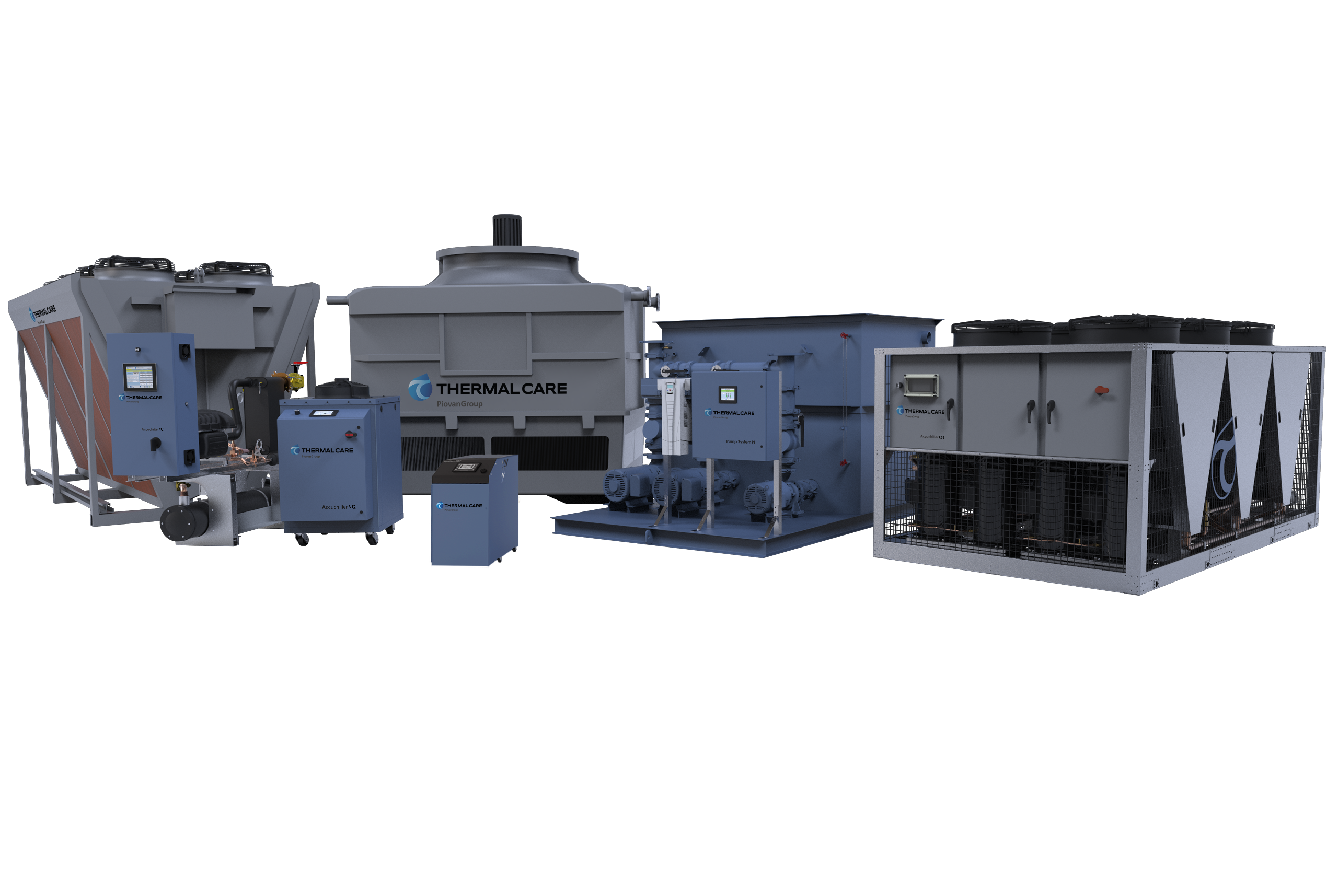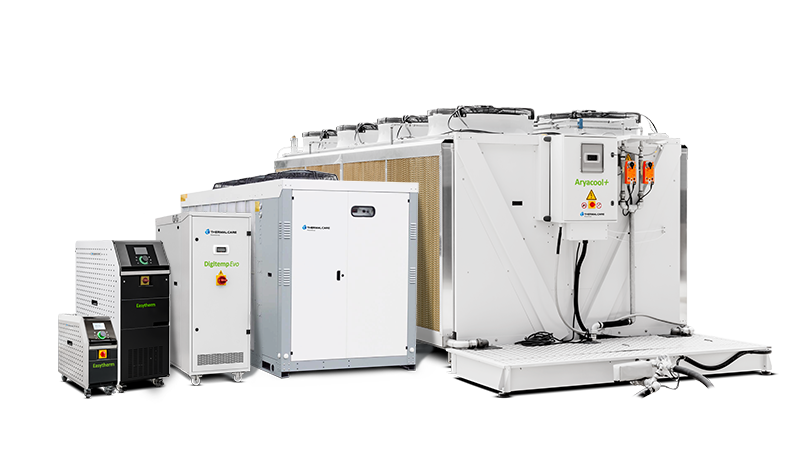Glossary
A
Outdoor equipment using forced air over air-to-fluid heat exchanger to cool a process fluid. Uses air drawn through water moistened medium. As water evaporates from medium, it cools before entering air-to-fluid heat exchanger. Used to achieve fluid temperatures lower than ambient air temperatures.
Condenser using forced air over air-to-fluid heat exchanger to reject heat from refrigeration circuit.
B
Variation of plate type heat exchanger with permanently fused plates eliminating need for frame. Extremely compact and energy efficient.
Unit of energy measure to increase 1 lb of water by 1°F - imperial system.
C
Type of non-displacement compressor using a spinning impeller to create outward force in volute to achieve compression.
Nominal rating for heat rejection capacity of a chiller. Based on about of energy required to melt 1 ton (2,000 lbs) of ice in 24 hours. 12,000 Btu/hr
Component of refrigeration circuit acting as a pump to circulate refrigerant and adds pressure and heat.
Informal variation of cooling ton that accounts for heat of compression added by a refrigeration compressor. 15,000 Btu/hr
D
The temperature when moisture leaves the air and will condense on objects that are at or below that temperature, just as dew forms on grass and plant leaves.
Read from an ordinary thermometer equipped with a “dry bulb” is basically the temperature of “ambient air”, un-effected by moisture.
Chiller with two refrigeration and two water loops, completely independent and implemented for increased efficiency and redundancy.
E
Component of refrigeration circuit controlling the amount of refrigerant released into the evaporator to regulate superheat of vapor leaving evaporator. Precisely controlled via programming logic and pressure sensors.
Component of refrigeration circuit used to transfer heat from process fluid into chiller.
Component of refrigeration circuit used to meter refrigerant to the evaporator, removes pressure to change state from liquid to vapor. See electronic and thermostatic for types.
F
Outdoor equipment using forced air over air-to-fluid heat exchanger to cool a process fluid. Cooling capacity relies mainly on air flow, heat exchanger surface area, and ambient air temperature.
Partition used in dual well tank to physically isolate the fluids in each well, eliminates any mixing.
G
Chemical added to water to protect from freezing. Percentage of concentration affects minimum allowable temperature.
H
Equipment used to transfer energy from one medium to another. See brazed plate, plate and frame, shell and tube for types.
Method of capacity control to add false load on an evaporator. Ensures compressor operates continuously avoiding cycling and maintaining temperature control.
J
A basic unit of thermal energy equal to the work done by a force of one newton acting through a distance of one meter.
K
Unit of measure of power (energy transfer rate) equal to joule/second - metric system.
L
Energy absorbed or released by a change of matter's state, i.e. - evaporation from liquid to gas absorbs latent energy.
Modifications made to a chiller to allow startup and operation in cold temperatures. Typically addresses temperatures from 65°F down to -20°F.
M
Component used to eliminate contact surfaces of traditional bearings. Allows elimination of oil from system.
Relay using coils, magnetic fields, springs, and mechanical contacts to switch a supply.
Used to determine main power wire size and guarantee wiring will not overheat under expected operating conditions.
N
Rating of chiller or cooling tower based upon agreed upon conditions such as set point and ambient air temperature.
P
Partition used in dual well tank to thermally isolate the hot and cold wells while allowing equalization when the flow rates out of each well are unequal.
Heat exchanger using plates mounted on a frame that are mechanically sealed with tightened endplates. Cleanable and efficient.
Sensor that converts pressure into an analog electrical signal, often used with variable speed drives for pumping systems.
Industrial computer control adapted for manufacturing or other automated applications.
R
Type of positive displacement compressor using piston(s) and cylinder(s) to achieve compression.
The ratio of how much moisture is in the air divided by the maximum amount of moisture that air can hold. Note below that a fixed amount of moisture in the air changes the “relative” humidity based on the dry bulb temperature of that air. Warmer air can hold a greater volume of moisture.
Air-cooled condenser separated from chiller, installed in a different location, typically outdoors, to allow heat rejection in a preferred location.
Probe that uses linear resistance change to measure temperature.
Piping used to protect the supply line to an elevated cooling tower from freezing. Installed before the supply line exits the building to gravity drain fluid exposed to outside ambient temperatures when system is off.
S
Type of positive displacement compressor using rotary screws in a continuous sweeping motion to achieve compression.
Type of positive displacement compressor using circular motion of two scroll plates (one moving, one fixed) to achieve compression.
Energy absorbed or released by the change in temperature of a matter state without change the state, i.e. - raising temperature of water from 50°F to 60°F absorbs sensible energy.
Desired temperature exiting a chiller, cooling tower, or fluid cooler. Input by user and controlled to by equipment.
Heat exchanger using shell vessel with internal pipes (or tube bundles). Large passageways allow contaminated fluids without risk of clogging.
Occurs when a compressor regularly experiences low load and must shut off to avoid over cooling.
Motor starter used to ramp up the current into the motor, avoid peak amperage spikes.
Relay with no moving parts using electrical and optical properties of solid state semi-conductors to perform input and output isolation.
T
Amount of time water is designed to remain in a tank, used to predict turnover period for tank volumes.
Component of refrigeration circuit controlling the amount of refrigerant released into the evaporator to regulate superheat of vapor leaving evaporator. Controlled via sensing bulb logic mechanically actuating expansion valve.
V
Method of capacity control to adjust a motor's input frequency to match the demand. Commonly used for pumps, fans, and compressors in process cooling systems.
W
Condition in process equipment that notifies operator of potential condition for pending alarm scenario.
Condenser using water-to-fluid heat exchanger to reject heat from refrigeration circuit.
Using the same thermometer as a dry bulb, but now equipped with a dampened wick on the bulb. The difference between the wet bulb and dry bulb temperatures is caused by the cooling effect of the evaporation of moisture from the wick. This evaporation effect reduces the temperature of the bulb’s temperature reading.




